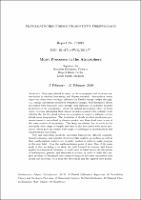Abstract
Processes related to water in the atmosphere lead to severe uncertainties in weather
forecasting and climate research. Atmospheric water vapor and cloud water strongly
influence the Earth's energy budget through, e.g., energy conversions associated
with phase changes, fluid dynamical effects associated with buoyancy, and through their
influence on radiative transfer properties of the atmosphere. Given the critical green-house
effect of water vapor, it seems astounding that climate modellers cannot with certainty state
whether the Earth's cloud system has a positive or negative influence on the global mean
temperature. The formation of clouds involves small-scale processes currently unresolved by
climate models, and thus cloud cover is one of the main sources of uncertainty. This large
uncertainty has its roots in the extremely wide range of length and time scales associated
with moist processes, which pose an equally wide range of challenges to mathematical and
computational modelling.
New and innovative methods, modeling frameworks, efficient computational techniques, and complex statistical data analysis procedures as well as their mathematical analysis are urgently needed in order to make progress in this new field -- from the mathematicians point of view. One of the main goals of this workshop is to show the path forward for current and future applied mathematical scientists, to work hand in hand across the disciplines of mathematics, physics, and atmospheric science, in order to tackle the complex problem of dynamical and thermodynamical processes associated with clouds and moisture, both from the theoretical and the applied view points.

